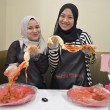By Azanis Shahila
Korea is one of the world’s best at branding itself through food using its cuisine as a kind of soft power to help spread South Korea’s influence. And yet as the government holds its citizens in opening Korean restaurants around the globe, it pays particular care to promoting that most ubiquitous of Korean foods, ‘kimchi’.
Kimchi, also spelled ‘gimchi’ or ‘kimchee’, refers to a traditional Korean fermented dish made of seasoned vegetables.
Kimchi is a red, fermented cabbage dish made with a mixture of salt, vinegar, garlic, chilly peppers and other spices. These ingredients are fermented in a tightly closed jar and are subsequently served with rice, noodles or soups in every Koreans household.
œThere are more than 300 different forms of kimchi, depending on the main ingredient used, and the region or time of year in which they are produced. Kimchi is Korea’s national dish and one that’s eaten with almost every meal, said Tam Tsz Wa, who is one of the teachers from the School of Kimchi in Seoul.
Kimchi is ready to eat right from its container all year round. Its firm, tender, crispy texture and its fresh, fully refreshing taste makes an exotic popularity. For kimchi eaters, there is no other food that can attain the same appeal as kimchi. Kimchi is eaten by Koreans so much that this food is oftentimes found in Korean movies and television shows alike.
œKimchi can be categorised into two different types which is vegetable kimchi, and seafood kimchi, but seafood kimchi can only be found in Korea not in another country because the primary ingredients used should originate from Korea, otherwise, the taste would not be the same, she added.
When I was having a vacation in South Korea during this autumn recently, the first thing that occurred to my mind is to try some Korean food. A Korean tour guide for my trip, Kim Sang Mol or Andy, as he preferred to be called said, “Kimchi is Korea’s representative ethnic and unique food, without anything similar in other nations, therefore, if you want to try the Korean food you have to try our kimchi first.”
Kimchi has been part of Korean tradition in so many ways. One of the ways is by saying ‘kimchi’ instead of ‘cheese’ while they are taking photographs. Koreans say ‘kimchi’ when they are taking pictures pretty much. In English, photographers usually say ‘cheese’ to make people smile in pictures.
In Korea, when photographers count 1,2,3 or 3 to 1, those being photographed say ‘kimchi’ by themselves. As the pronunciation of ‘cheese’ makes the persons mouth to smile, of which ‘kimchi’ also makes a person smile.
Andy said when taking our photograph, œPronounce it with me! Kim-chi. You should draw out the pronunciation of ˜chi as ˜chee and do the ˜V sign with your two fingers (thumb and forefinger) when saying ‘kimchi’ while taking photographs.
To tell the truth, making ˜v sign and say ˜kimchi is not relevant at all, but, people do it together generally.
I had the opportunity to interview a few members of public on the reasons why Korean people enjoy eating kimchi. Many of them said that kimchi is part of their culture and tradition. Besides, there are some of them who answered that it is because kimchi is high in vitamin to help boost their health.
Kim Ye Eun, who is a teacher from Seocho-GU high school in Seoul said, œThe reason why so many of our people love to eat Kimchi is because it has a lot of benefits to our health.
œWhile for me, I love to eat kimchi since I was young, and I believe that kimchi makes my skin flawless, looks radiant and healthy, she added.
To quote what some studies have found, œChinese cabbage and radish found in kimchi contain bio-chemicals such as isocyanate and sulphide helpful in detoxifying heavy metals found in your liver, small intestine and kidney.
œThese bio-chemicals, particularly isocyanate, are considered capable of preventing stomach cancer easily, observed Professor Miri Kim of Food Nutrition Department in Chungnam National University.
Besides, other studies done by Professor Rina Yu of Food and Nutrition Department in the University of Ulsan found that œkimchi causes the immune cells to be more active and the antibodies to be more abundant.
œEating a high cholesterol diet can give 55 per cent immune cell activity, a normal diet can give 68 per cent but a high cholesterol diet plus kimchi can give 75 per cent.
During this trip, I also had a chance to visit Kimchi Field Museum in Seoul. This museum informs international visitors about kimchis history, varieties, and value. Open to general public, the museum provides unique insight into Korean favourite dish.
The museum collects data on kimchi related resources and statistics, offering participation in kimchi related activities, such as the kimchi making process and kimchi tasting each month. The museum makes it as a mission to provide visitors with the most complete historical view of kimchi in one place.
The museum is divided into three sections. I spent almost two hours in that museum to find out many interesting facts about kimchi. Overall, I get so much knowledge from this trip that helps me to know more about Korean culture and cuisine.
œI think food is not just a thing we eat for a living, says Andy. œFood helps us trust each other. In Korea, we have a saying: Whoever prepares for you the good meal, you cannot betray them.” ***



